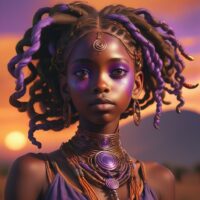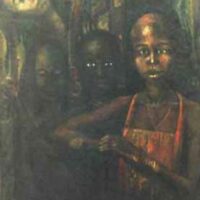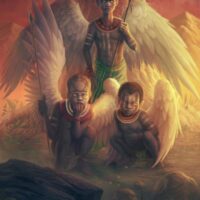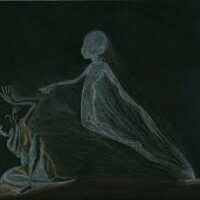Ogbanje : The Spirit Children
Listen
At a glance
| Description | |
|---|---|
| Origin | West African Mythology |
| Classification | Spirits |
| Family Members | N/A |
| Region | Nigeria |
| Associated With | Reincarnation |
Ogbange
Introduction
The Ogbanje is a captivating entity from West African mythology, particularly among the Igbo people. Translated as “children who come and go” in the Igbo language, the term refers to a being thought to be an evil spirit that deliberately afflicts a family with misfortune. Within the rich tapestry of West African mythology, which brims with fascinating creatures, the Ogbanje occupies a unique and intriguing space. Unlike monstrous beasts, Ogbanje are portrayed as children intricately entwined with the spirit world, leading to a complex and often tragic existence. These enigmatic spirits, originating from the Igbo culture in Nigeria and neighboring regions, have captivated the imaginations of storytellers and scholars across generations.
Physical Traits
The Ogbanje is not typically associated with a specific physical form. Instead, it is known for its ability to reincarnate, taking on the form of human children within the same family. Some legends speak of Ogbanje returning with physical scars from their previous lives. Descriptions of an Ogbanje’s appearance vary widely. Some accounts portray them as possessing an almost unsettling beauty, intelligence, and charm. Others suggest they may bear subtle marks hinting at their otherworldly nature—such as birthmarks, unusual colored eyes, or a distant look in their gaze.
Ultimately, an Ogbanje blends in seamlessly, concealing their true essence beneath the surface. Describing the physical form of an Ogbanje is akin to grasping at mist. They are said to possess an otherworldly allure, often appearing as strikingly attractive children with haunting eyes that seem to hold ancient secrets and wisdom beyond their years. Yet, despite their captivating appearance, Ogbanje are believed to be transient beings, capable of effortlessly slipping between the realms of the living and the spirit world.
Family
The Ogbanje is not tied to a conventional family structure but is believed to reincarnate within the same immediate or extended family repeatedly. This cycle of birth and premature death brings profound grief to affected families. In West African mythology, the Ogbanje are deeply connected to ideas of reincarnation and familial bonds. These spirits are thought to be born into human families but possess the ability to transition back to the spirit world at will, leaving their earthly relatives in a perpetual state of sorrow and confusion.
Families troubled by an Ogbanje child often endure a recurring pattern of birth and premature death, perpetuating a haunting sense of sorrow and mystery. Central to the belief surrounding the Ogbanje is their cyclical journey of death and rebirth. They are viewed as spirits who select a family, entering the world only to depart young, frequently under mysterious circumstances. This repetitive cycle burdens the family with immense grief, facing the emotional and psychological toll of losing a child, only to confront the prospect of their return.Traditional methods to identify or appease the Ogbanje spirit vary among cultures. Some employ scarification to mark the child, believing it will deter the spirit’s return. Others engage in rituals involving divination or offerings to pacify the spirit and break the cycle of death.
Other names
In the Igbo language, the term Ogbanje has occasionally been used interchangeably for a defiant or headstrong child. This association with fairy changelings from Celtic and broader European mythology has led to the translation of Ogbanje as “changeling.” Across diverse West African cultures, these spirits are known by various names reflecting local beliefs and traditions. In Igbo culture, they are commonly known as “Nso Ala” or “Children of the Earth,” highlighting their connection to the spirit realm and natural world. Among the Yoruba people, similar entities are referred to as “Abiku,” denoting a child fated to die young and return to afflict their family.
The belief in spirit-children with a propensity for recurring presence extends beyond the Ogbanje and is manifested in different names and cultural nuances across West Africa. The Yoruba identify them as Abiku, while the Ewe people refer to them as Aisin. Despite these variations, the fundamental concept of a cyclical spirit bound to a particular family remains a constant theme.
Powers and Abilities
The Ogbanje’s primary power lies in its ability to reincarnate within the same family. It is believed that an Ogbanje intentionally dies shortly after birth, typically before reaching puberty, only to be reborn as the next child in the family, continuing the cycle. This spirit is also associated with causing frequent illnesses or disturbances.
The Ogbanje is said to possess stones known as “iyi-uwa,” which they bury in secretive locations. These stones enable the Ogbanje to return to the human world and locate their chosen family. Destroying the iyi-uwa is thought to prevent the Ogbanje from further troubling the family.
The powers attributed to the Ogbanje are multifaceted and unsettling. These spirits are believed to possess an intrinsic understanding of the supernatural, often displaying exceptional intelligence and foresight beyond mortal comprehension. Ogbanje are thought to wield control over life and death, evading mortality through their connections to the spirit realm. They may haunt dreams, inflict mysterious illnesses upon their families, or vanish without a trace, leaving behind an eerie sense of melancholy.
The Ogbanje’s mysterious connection to the spirit world imbues them with an aura of enigma. Some believe they possess supernatural abilities, such as the power to manipulate their health, orchestrating their own deaths to return to the spirit realm. Others suggest they have heightened intelligence or an uncanny knack for influencing events around them. It’s crucial to acknowledge that these interpretations are rooted in cultural beliefs, and the true extent of the Ogbanje’s abilities remains veiled in myth.
Modern Day Influence
The influence of the Ogbanje concept extends into modern literature and culture. In Chinua Achebe’s renowned novel “Things Fall Apart,” the character Ezinma is depicted as an Ogbanje because she is the first of her mother’s ten children to survive infancy. While belief in the Ogbanje in Igboland has waned over time, some individuals still hold onto these beliefs. Certain theorists propose that these mythological conceptions originally served as explanations for mysterious diseases that often claimed the lives of children.
Despite advances in modern medicine reducing child mortality rates, remnants of the notion of a child as an omen of misfortune can linger in certain communities, resulting in stigmatization and isolation for families who endure repeated childhood losses. However, the Ogbanje myth also provides a framework for understanding grief and loss. The rituals and customs associated with the Ogbanje can be viewed as coping mechanisms for families grappling with the emotional devastation of losing a child.
Moreover, the Ogbanje narrative has become a recurring theme in contemporary West African literature. Writers like Chinua Achebe and Chimamanda Ngozi Adichie delve into the intricacies of the Ogbanje myth, using it as a lens to explore themes of family dynamics, resilience, and humanity’s struggle with mortality. Through their works, they invite readers to contemplate the profound depths of human experience and the enduring influence of cultural beliefs.
Related Images
Frequently Asked Questions
What is lorem Ipsum?
I am text block. Click edit button to change this text. Lorem ipsum dolor sit amet, consectetur adipiscing elit. Ut elit tellus, luctus nec ullamcorper mattis, pulvinar dapibus leo.
What is lorem Ipsum?
I am text block. Click edit button to change this text. Lorem ipsum dolor sit amet, consectetur adipiscing elit. Ut elit tellus, luctus nec ullamcorper mattis, pulvinar dapibus leo.
What is lorem Ipsum?
I am text block. Click edit button to change this text. Lorem ipsum dolor sit amet, consectetur adipiscing elit. Ut elit tellus, luctus nec ullamcorper mattis, pulvinar dapibus leo.
What is lorem Ipsum?
I am text block. Click edit button to change this text. Lorem ipsum dolor sit amet, consectetur adipiscing elit. Ut elit tellus, luctus nec ullamcorper mattis, pulvinar dapibus leo.
What is lorem Ipsum?
I am text block. Click edit button to change this text. Lorem ipsum dolor sit amet, consectetur adipiscing elit. Ut elit tellus, luctus nec ullamcorper mattis, pulvinar dapibus leo.









